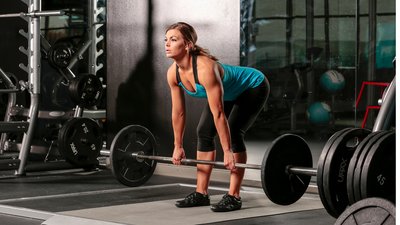Think about your last leg workout, how many quad dominant exercises did you do? How many hip extensor dominant exercises did you do? Was there a balance between the two? Do you even know the difference?
Most Leg Exercises
Most leg exercises fall under the quad dominant category. Squats, deadlifts, leg presses and the like are all quad dominant exercises. While the hip extensor muscle groups (hamstrings and glutes) are activated during these movements, the quads take most of the training stress, and therefore receive the largest training response. If you do not make a conscious effort to balance your quad and hip extensor training, you will eventually develop a strength imbalance between the two muscle groups.
This imbalance can lead to several less than desirable conditions, with both physical (frequently pulled hamstrings) and cosmetic (less than perky backside) manifestations. Because hip extensor training can have such a wide range of benefits, it makes sense for everyone to include it in their training program—from general health and fitness clients looking for some improved "assets," to athletes looking for improved performance and injury prevention.
So what exactly are hip dominant exercises? The hip extensors are the muscle groups that act to extend the hip which, as mentioned earlier, are primarily the hamstrings and the glutes. When most people hear the word "hamstrings" attached to the hip extensor definition, they automatically start to think "leg curls," and why not? Leg curl variations are probably the most common and popular hamstring exercises in the history of the iron game.
In fact, if you asked someone in the gym who was doing leg curls to name another exercise that targeted the hamstrings, they would probably give you a blank stare and go back to reeling off their 12 reps on the lying leg curl machine.
But guess what? Leg curls are not hip dominant exercises. To qualify as one, there has to be movement at the hip joint, and the leg curls simply do not do this, making them a poor choice for balancing the strength levels between the two main sections of the upper leg.
So, considering that the only exercise that most people associate with hamstring training is woefully inadequate for our ultimate purposes, what should you be doing as a hip dominant exercise? One of the most effective, most overlooked, and on the rare occasion it is performed, most poorly executed exercises for this purpose is the Romanian Deadlift (RDL).
The RDL isn't a true deadlift, and its origins are not Romanian (American lifters saw a World Champion weightlifter from Romania performing this exercise back in the '50's and dubbed it the "Romanian Deadlift"). The term RDL proved to be a catchy name, and has stuck with this exercise throughout the years. Certified Fitness Instructors with the ISSA will recognize this exercise from the CFT text, although Dr. Hatfield referred to it by another less common name, "keystone deadlifts."
First let's establish what proper form is for this exercise, before we start to get into why it's one of the best hip extensor exercises available to you, and how you should integrate it into your training program.
How To Perform The RDL (Romanian Deadlift)
Set the racks in a power rack to just about knee level (there is no need for safety rods—if you lose control during a lift, simply drop the weight), and set a standard Olympic bar on the rack. Walk up, squat down slightly while maintaining a small curve in the lower back, grasp the bar, and stand back up. You want your hands to be shoulder width apart, perhaps slightly wider if you find it to be more comfortable. Take a few steps back, and set yourself for the exercise. Being set includes making sure your feet are shoulder width apart, your chest is up, your lower back has a slight curve in it, and your knees are slightly bent (not locked). Once set you're ready to start the exercise.
Start by tightening your core musculature (abs and lower back) to ensure a secure spine. Keeping the bar close in to your body (it should maintain slight contact with the body at all times) start to bend at the hips, taking care that the lower back does not move.
It may take some people a few sessions of practice to make this distinction. Your lower back should not loose its natural curvature at any time during the movement. Loosing this curve and bending or even straitening the lower back will put your lower back in a potentially injurious position. Practice with a light weight until you can bend over at the hips without bending the lower back as well.
As you descend, your butt should move back ever so slightly and you should feel a stretch in your hamstrings. In fact, I find it's easier to learn this exercise if you visualize it as a hamstring stretch with no lower back movement. Most people will find that they can safely bring the bar down to around knee level before their lower back begins to straighten.
At the point right before you reach the limit of your hamstring range of motion you should stop and then reverse the movement, taking care to keep the bar in close and maintaining a safe (slightly curved) lower back position. Towards the top of the movement really force the hips through be squeezing the glutes. Repeat for the prescribed number of repetitions, walk the bar in over the racks, squat down slightly and return the bar to the rack.
The biggest mistake most people will make in the execution of this exercise is not maintaining the position of their lower back. Some will even go so far as to bend all the way over till the weight touches the ground. This is a huge no-no and is a reflection of the misunderstanding of this exercise and its purposes by most fitness instructors. It is not meant simply as a hamstring stretch as some would claim, nor is it meant to directly work the lower back, although the lower back will get stronger from performing this exercise.
In order to properly stress the hip extensor muscle groups, you must use intensity levels that are much too high for the lower back to handle in a prime mover or synergistic role. In order to derive maximum benefits from the RDL, you must keep the lower back from moving and let it play a much safer role as a stabilizer.
In fact, if done properly, you can safely handle extremely large weights on this movement with little to no danger to your lower back. I have personally done 405 pounds for sets of 8 on this movement with absolutely no ill effect on my lower back (that's for all the "don't go heavy, it's dangerous for your lower back" critics out there).
What Makes The RDL So Great?
Two words—intensity and functionality. First, the RDL allows a much higher intensity level (basically more weight can be used) than a leg curl does. Considering that hamstrings are made up of primarily fast twitch muscle fibers which are best trained with higher intensity levels, the RDL is one of the most effective hamstring exercises you can do.
Second, the RDL is also far more functional than leg curls. Sorry folks, but leg curls are not a functional exercise. Although it may seem like knee flexion is a big part of your every day activities like running and walking, a look at the true biomechanics of these activities shows that it is, in fact, hip extension that plays the major role in these activities.
Your knee simply flexes in order to reset the leg and start the locomotion movement again, and even there the momentum generated from the hip extension helps swing the lower leg back. Hip extension plays a huge role in several everyday activities, such as the above mentioned running and walking, not to mention jumping and biking. In addition, when you learn to bend over with a heavy weight in the gym while protecting your lower back, you have learned better body mechanics for use outside the gym as well.
There is one last thing that makes the RDL special, at least in most of my client's eyes. I've yet to find an exercise that delivers better results as far as firming up the hindquarters, if you catch my drift. I've had dozens of frustrated people come to me after years of leg lifts and donkey kicks and all sorts of other silly exercises that supposedly target the glutes. These frustrated athletes are ready to give up their dream of looking good in tight pants again.
After a little instruction, every single one of them saw better and more satisfying results in just a few months of executing the RDL than all their previous training combined. Some may scoff at it, but most people work out with an eye on improving their physique, so these benefits do rank high on a lot of people's priority list.
When you add the RDL (or any other hip extensor exercise) into your program, your best bet is to split your leg work up over two different days. Day one, use a quad intensive exercise; day two, use a hip extensor intensive exercise. Allow at least two days between your two leg workouts so as not to overly stress any of the stabilizers and synergists that assist in lower body movements.
I've found the following split to be very effective:
- Day 1: Leg Workout #1 (Quad Dominant)
- Day 2: Chest/Biceps
- Day 3: Rest
- Day 4: Leg Workout #2 (Hip Extensor Dominant)/Back/Triceps
- Day 5: Shoulders/Abs/Rotator Cuff
- Day 6: Rest
- Day 7: Rest
Check out our exercise database for exercise desciptions and pics!
And check out our workout database and design a workout program to fit your needs!
Note: You'll probably notice that there is no direct tricep work, and that is because I prefer to use pressing movements such as bench press and military press to work the triceps.
Since I split my chest and shoulder work up over two days, I've effectively hit the triceps twice in one week, making more direct work unnecessary and possibly counterproductive. Look at your training log (you do keep one, don't you?) and take a peek at your last dozen or so leg workouts. Odds are all of them used nothing but quad dominant exercises with perhaps some leg curls thrown in. Isn't it about time you stopped working only half your upper leg musculature? Now that you know the benefits, you'd be a fool not to start incorporating the RDL into your routine. After all, who doesn't want to run faster, jump higher and be able to bounce a quarter off their butt?

